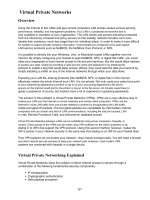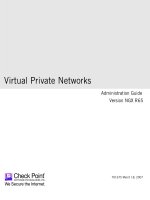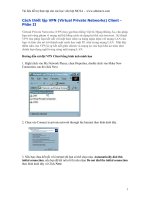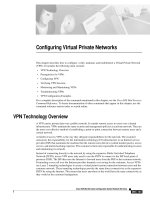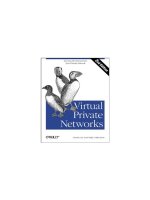en CCNAS v11 ch08 implementing virtual private networks
Bạn đang xem bản rút gọn của tài liệu. Xem và tải ngay bản đầy đủ của tài liệu tại đây (4.77 MB, 169 trang )
Implementing Virtual Private Networks
© 2012 Cisco and/or its affiliates. All rights reserved.
1
VPN Terminology
© 2012 Cisco and/or its affiliates. All rights reserved.
2
Cryptosystem
•
A system to accomplish the encryption/decryption, user authentication, hashing, and key-exchange processes.
•
A cryptosystem may use one of several different methods, depending on the policy intended for various user
traffic situations.
© 2012 Cisco and/or its affiliates. All rights reserved.
3
Encryption / Decryption
•
Encryption transforms information (clear text) into ciphertext which is not readable by unauthorized users.
•
Decryption transforms ciphertext back into clear text making it readable by authorized users.
•
Popular encryption algorithms include:
–
DES
–
3DES
–
AES
© 2012 Cisco and/or its affiliates. All rights reserved.
4
Authentication / Hashing
•
Guarantees message integrity by using an algorithm to convert a variable length message and shared secret key
into a single fixed-length string.
•
Popular hashing methods include:
–
SHA (Cisco default)
–
MD5
© 2012 Cisco and/or its affiliates. All rights reserved.
5
Non-repudiation
•
Is the ability to prove a transaction occurred.
–
•
Similar to a signed package received from a shipping company.
This is very important in financial transactions and similar data transactions.
© 2012 Cisco and/or its affiliates. All rights reserved.
6
Diffie-Hellman Key Exchange
•
How do the encrypting and decrypting devices get the shared secret key?
–
The easiest method is Diffie-Hellman public key exchange.
•
Used to create a shared secret key without prior knowledge.
•
This secret key is required by:
–
The encryption algorithm (DES, 3DES, AES)
–
The authentication method (MD5 and SHA-1)
© 2012 Cisco and/or its affiliates. All rights reserved.
7
Pre-Shared Key
•
Identifies a communicating party during a phase 1 IKE negotiation.
•
The key must be pre-shared with another party before the peers routers can communicate.
© 2012 Cisco and/or its affiliates. All rights reserved.
8
IPsec - Internet Protocol Security
•
A “framework” of open standards developed by the IETF to create a secure tunnel at the network (IP) layer.
–
•
It spells out the rules for secure communications.
IPsec is not bound to any specific encryption or authentication algorithms, keying technology, or security
algorithms.
© 2012 Cisco and/or its affiliates. All rights reserved.
9
IPsec Protocol Framework
© 2012 Cisco and/or its affiliates. All rights reserved.
10
Crypto Map
•
•
A Cisco IOS software configuration entity that performs two primary functions.
–
First, it selects data flows that need security processing.
–
Second, it defines the policy for these flows and the crypto peer that traffic needs to go to.
A crypto map is applied to an interface.
© 2012 Cisco and/or its affiliates. All rights reserved.
11
SA - Security Association
•
Is a contract between two parties indicating what security parameters, such as keys and algorithms will be used.
•
A Security Parameter Index (SPI) identifies each established SA.
© 2012 Cisco and/or its affiliates. All rights reserved.
12
Cryptography Names
•
•
•
•
•
•
Alice and Bob
–
–
–
Are commonly used placeholders in cryptography.
Better than using Person A and Person B
Generally Alice wants to send a message to Bob.
Carol or Charlie
–
A third participant in communications.
Dave is a fourth participant, and so on alphabetically.
Eve
–
–
An eavesdropper, is usually a passive attacker.
She can listen in on messages but cannot modify them.
Mallory or Marvin or Mallet
–
–
A malicious attacker which is more difficult to monitor.
He/She can modify and substitute messages, replay old messages, etc.
Walter
–
A warden to guard Alice and Bob depending on protocol used.
© 2012 Cisco and/or its affiliates. All rights reserved.
13
VPNs
© 2012 Cisco and/or its affiliates. All rights reserved.
14
Conventional Private Networks
© 2012 Cisco and/or its affiliates. All rights reserved.
15
Virtual Private Networks
© 2012 Cisco and/or its affiliates. All rights reserved.
16
VPNs
•
A Virtual Private Network (VPN) provides the same network connectivity for remote users over a public
infrastructure as they would have over a private network.
•
VPN services for network connectivity include:
–
Authentication
–
Data integrity
–
Confidentiality
© 2012 Cisco and/or its affiliates. All rights reserved.
17
Characteristics of VPNs
© 2012 Cisco and/or its affiliates. All rights reserved.
18
VPN Concepts
•
A secure VPN is a combination of concepts:
© 2012 Cisco and/or its affiliates. All rights reserved.
19
VPN Packet Encapsulation
© 2012 Cisco and/or its affiliates. All rights reserved.
20
VPN Packet Encapsulation
© 2012 Cisco and/or its affiliates. All rights reserved.
21
VPN
Topologies
© 2012 Cisco and/or its affiliates. All rights reserved.
22
Two Types of VPNs
•
•
Site-to-Site VPNs:
–
Intranet VPNs connect corporate headquarters, remote offices, and branch offices over a public infrastructure.
–
Extranet VPNs link customers, suppliers, partners, or communities of interest to a corporate Intranet over a public infrastructure.
Remote Access VPNs:
–
Which securely connect remote users, such as mobile users and telecommuters, to the enterprise.
© 2012 Cisco and/or its affiliates. All rights reserved.
23
Site-to-Site VPNs
© 2012 Cisco and/or its affiliates. All rights reserved.
24
Site-to-Site VPNs
© 2012 Cisco and/or its affiliates. All rights reserved.
25
